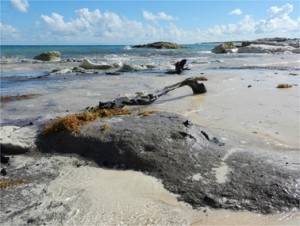View Source | February 13, 2014

Assembling a picture of past environments always involves detective work. The reward is a clearer understanding of how natural and human forces have changed environments in the past, giving insights to how modern-day environmental changes take place.
Working with especially elusive evidence, Janet Franklin, ASU professor of geography, is participating in an effort to understand the profound changes in plant and animal life that occurred on the oceanic islands of the West Indies since the end of the last ice age.
A paper recently published by Franklin and her colleagues – scientists from University of Florida (including lead author David Steadman), the Commonwealth of the Bahamas and Eastern Tennessee State University – reports on an intriguing fossil deposit discovered on Abaco Island in the northern Bahamas in 2009. The fossils are embedded in a layer of peat – organic soil – that is buried under beach sand and is only exposed a few days a year, during extremely low tides.
In the years since the peaty sediment was first discovered, Franklin and her colleagues, along with the owner of the area, have taken advantage of brief low-tide periods to collect samples of the peat and extract fossils. Their finds range from remains of an extinct large tortoise (Albury’s tortoise) to the extirpated Cuban crocodile (no longer found anywhere except a small region of Cuba), to small fragments of plants and mollusks.
Radiocarbon dating shows the peat and its fossils to be 900-950 years old, which coincides with the first arrival of people on Abaco. (These first settlers were Lucayan Taino Amerindians – the first peoples encountered by Christopher Columbus in the New World, 500 years later.)
The charcoal-rich sediments suggest that the peat was deposited very quickly when these agricultural people first colonized the island and began to clear land for their crops by burning. Thus, fossils retrieved from this peat deposit in Gilpin Point, Abaco, represent animal life at the time of first human presence.
Of the 17 identified species of amphibians, reptiles, birds and mammals the researchers found, only 10 still live on Abaco – a major change in the animal life on the island. Unhealed bite marks on the inside of the thick carapaces of the green turtle show that they were scavenged by Cuban crocodiles after being butchered by humans.
The concentrated remains of large, edible animals suggest that this was an Amerindian kitchen midden. Frustratingly, the researchers initially found almost no cultural artifacts in the peat deposit. The most direct evidence of humans eventually discovered was one tiny polished shell bead. However, the deposit is only occasionally exposed and, undoubtedly, it has a large extent that is yet to be observed, much less studied.
Landowner Perry Maillis is a keen observer, and with his help and careful oversight from Nancy Albury, a vertebrate paleontologist with The Bahamas Antiquities, Museums and Monuments Corporation (AMMC), the team hopes to recover more material from this unique site in the future in order to learn about the fascinating prehistory of animals, plants and people in the northern Bahamas.
This research was funded by the National Science Foundation (grant BCS-1118369 to DWS, and BCS-1118340 to JF), with additional support from The Bahamas National Trust, AMMC and Abaco Friends of the Environment.
Janet Franklin is a professor in the School of Geographical Sciences and Urban Planning, an academic unit of the College of Liberal Arts and Sciences, as well as a senior sustainability scientist in the Global Institute of Sustainability.
The recently published paper is Late Holocene faunal and landscape change in the Bahamas.

